GOTY 2013 List
 Thursday, January 16, 2014 at 10:00AM
Thursday, January 16, 2014 at 10:00AM Here it is, my quite hard to produce top 10 list for 2013. I left out over a dozen other great games I got to play as well but this is where my heart fell.
Review: Battlefield 4
 Friday, December 13, 2013 at 12:48PM
Friday, December 13, 2013 at 12:48PM With the Fall release season comes our annual allotment of modern military shooters trying to thrill us with rollercoaster singleplayer campaigns and multiplayer suites with tons of DLC on the way. And, like any Fall season, it’s the usual suspects. Activision’s multi-studio, cyclical juggernaut series continued its annual early November onslaught this year but EA, always desperate to challenge Call of Duty to a backstreet brawl, released the fourth numbered entry in DICE’s rather great Battlefield series.
With a numbered title coming so soon after their last entry in the series though, does DICE’s latest and greatest create and innovate or is this new title more focused on refining the current formula of bang bang shoot’em up gameplay?
Click to read the full written review
What Would You Like on Your Tombstone?
Six years after a failed Russian separatist plot to ignite World War 3, US Special Forces squad Tombstone is ordered into Azerbaijan to retrieve intelligence confirming that a rogue Chinese Admiral plans to lead a coup d’état against the current government that will earn him the support of Russia. Shortly thereafter, Admiral Chang is able to convince the Chinese people that the US is responsible for the death of newly elected president Jin Jié. During a rescue mission Shanghai, an EMP device is detonated which affects much of the region, including Tombstone’s own homebase located on the USS Valkyrie. Crippled, blind and without direction from above, the men and women of the Valkyrie must do what they can to stop Chang before the conflict escalates out of control.
If you read that last paragraph and groaned over how generic it sounds, you are not alone. Battlefield 4’s story hits on all the major points of any commonplace military technothriller these days and, for almost all aspects of the singleplayer experience, has been done far better elsewhere. Across this 4-5 hour campaign, every twist and turn is neither surprising nor exhilarating with a cast of characters just as equally boring. It doesn’t even feature a proper ending or a final confrontation with the bad guy in question and with levels that feel overly long, the entire experience feels like a drag.
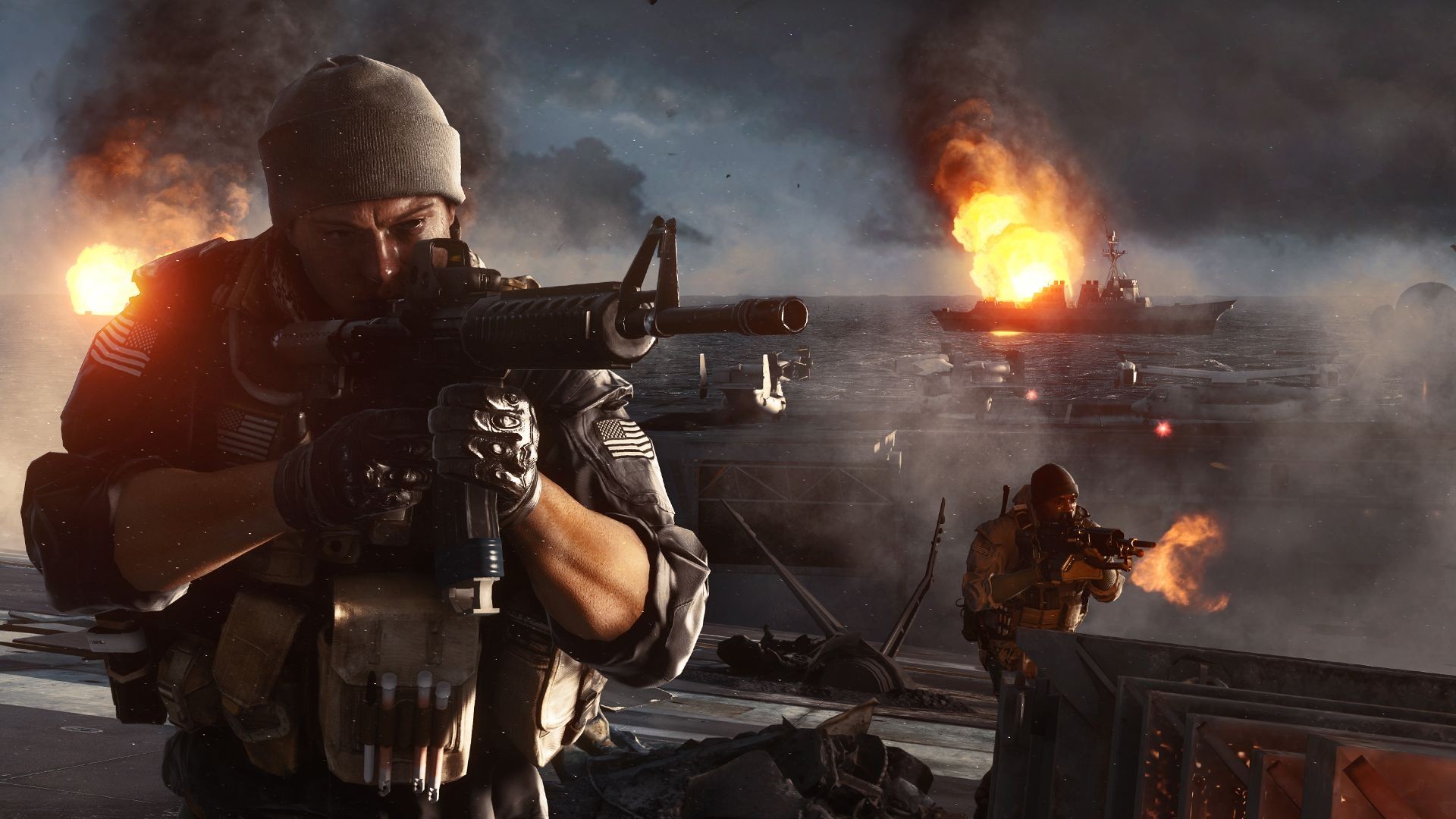
Considering DICE’s pedigree and the talent they have on hand, it’s a wonder why they haven’t been able to generate a good singleplayer story since 2008. The characters of Tombstone squad fit all the cliques one would expect from a soldier drama: the focused, on-mission warrior; the vain ‘save everyone or die trying’ emotional annoyance; the ‘I’m going to betray you but really not’ trust case the others will have petty arguments with. It has all been done before and almost all of the dialog present does nothing to break new ground. In fact, it feels as if DICE had plans for something far greater but didn’t have a tenth of the budget to make it as some of the dialog feels either unnecessarily without context or relayed in a tone unbefitting the moment in which it is said. Or it could just be bad writing, who knows.
I also find it strange that DICE felt the need to establish a continuity between Battlefield 3 and 4. To do so, our intrepid designers decided to throw in two characters from the 2011 singleplayer romp and, subsequently, kill them off. If you find yourself upset about that little spoiler then you clearly are more interested in the story than you should be. Neither of these characters were interesting or memorable to begin with and while I can appreciate why DICE would do this, what I really don’t understand is why they would go about it in this way. This might be another symptom of their eyes being bigger than their stomachs but it just doesn’t make any sense to me to bring back characters only to kill them shortly thereafter. This is not how you establish memorable protagonists and antagonists, DICE. I’ll remember characters like Reznov, Makarov, Price and Soap for a long time to come because they were pretty good in their own right. Kovic and Dima do not fit that bill.
Gameplay-wise, the campaign features little to be excited for. A squad order mechanic is implemented wherein the player presses a button and your squadmates fire upon a set amount of enemies in a given direction. The use of the order system is finicky at best both in targeting the enemies you actually want them to attack as well as the accuracy of the AI in question. What’s more confusing is the fact that your friendly AI is atrociously stupid at times and will, more often than not, walk within feet of an enemy and either miss with every shot or will simply ignore them entirely. It’s clear that DICE wants you to be the one to take out the vast majority of those who dare to point their weapons in your direction but you would figure that, since you are a part of an elite team of covert ops marines, they’d be able to help you out. And they will, albeit when it suits them.
What is clear however is that EA is once again pushing to grab the attention of the Call of Duty crowd while ignoring many of the selling points and attributes that make the Battlefield series far different from its competition. The singleplayer campaign is the victim of this drive to grab that audience’s attention and it is a sad attempt at best. Rather than focus on full spectrum warfare encompassing multiple roles in an overall greater conflict as Battlefield 3 attempted and the Battlefield series’ multiplayer as a whole achieves, this story is entirely focused on one character in a single set path with no real attention given to the greater effort at all. You do not get to see the weight of the implied conflict on the region nor the circumstances for which it matters. You go where you need to go and do as you are told. Once your role in the story is over nothing else happens. Nothing more.
What is the Battlefield 4 singleplayer experience like then? A boring, unnecessary slog that doesn’t warrant any attention. Next time, DICE, stick to your guns and ignore the competition.
Gonna Light ‘Em Up
Let’s be honest with ourselves here though: you don’t come to play a Battlefield game for the singleplayer. With this newest entry only coming two years after Battlefield 4, one should definitely ground their expectations of this title to being more of an expansion and refinement of Battlefield 3’s mechanics than a completely new, unique take. Happily, DICE took notice of Battlefield 3’s multiplayer being as good as it was and seems to be doing right by players by making it even better.
Happily, apart from the overall singleplayer experience, the multiplayer’s character class customization system is the only thing grafted from the Call of Duty series and adapted for the Battlefield formula and the results are graciously accepted. Each class still feels unique as far as their role on the field of play but this time around you have far more options as to class, weapon, and character customization. Though each class starts out with access to their own unique type of weapon (assault class to assault rifles, support class to LMGs and so on) each one eventually shares access to three additional weapon types: carbine rifles, shotguns and designated marksman rifles (DMRs). This frees up the player to customize their own ideal classes to an almost perfect degree and create the characters they want to fight as in just the right situations or, perhaps, in all types of firefights.
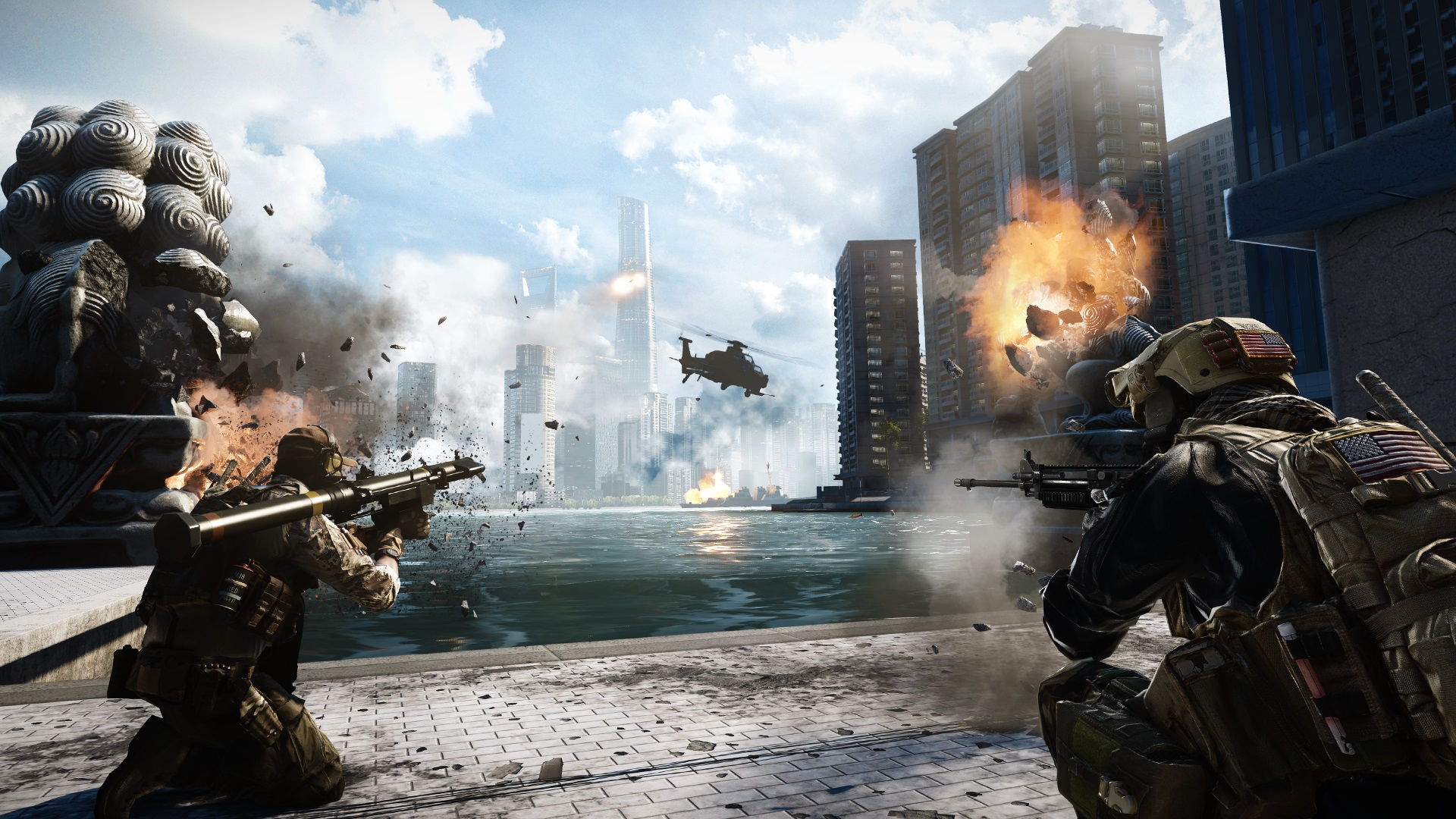
Customization also extends to your weapons in a rather great way. The previous title only had a handful of customization options and, even then, it was pretty spartan as to what you could add to firearms. Thankfully, DICE has increased the amount you can make weapons your own this time around by a strong magnitude. Weapons now have many, many more options available to them from grips to scopes, specialized sights to camouflage designs. Want to build a weapon built for medium to long range combat but still want to be covered when it comes to close encounters? Equip your rifle with a scope and canted ironsights. DICE has thrown in dozens (and I do mean dozens) of new camo designs as well.
The existing database of weapons and tools, in addition to receiving new ones, has also seen some strong and noticeable rebalancing. Sniper rifles now feel more set for their long range purpose with some of them being reclassified as DMRs befitting more short and medium-ranged focuses. Rocket launchers no longer feel useless in the face of a skilled pilot as some have the capability of reacquiring the target after they have deployed their countermeasures. Shotguns have been made far more powerful than they were in the previous iteration. Many more balance changes have been made to the multiplayer to make the weapons not only feel good but actually worthwhile to those who don’t switch to a new firearm immediately after unlocking a new one and you won’t find a single complaint in this regard.
A rather nice feature DICE has decided to throw into the mix is the inclusion of super weapons that are littered throughout each map. Ranging from a semi-automatic shotgun with explosive ammunition to a tri-rocket launcher, each is thoughtfully placed in locations where they would be the most useful and, to my confusion, very few people take advantage of them despite their inherent power. It doesn’t necessarily have a significant impact like a killstreak would in a Call of Duty title but they definitely can be useful at just the right moment.
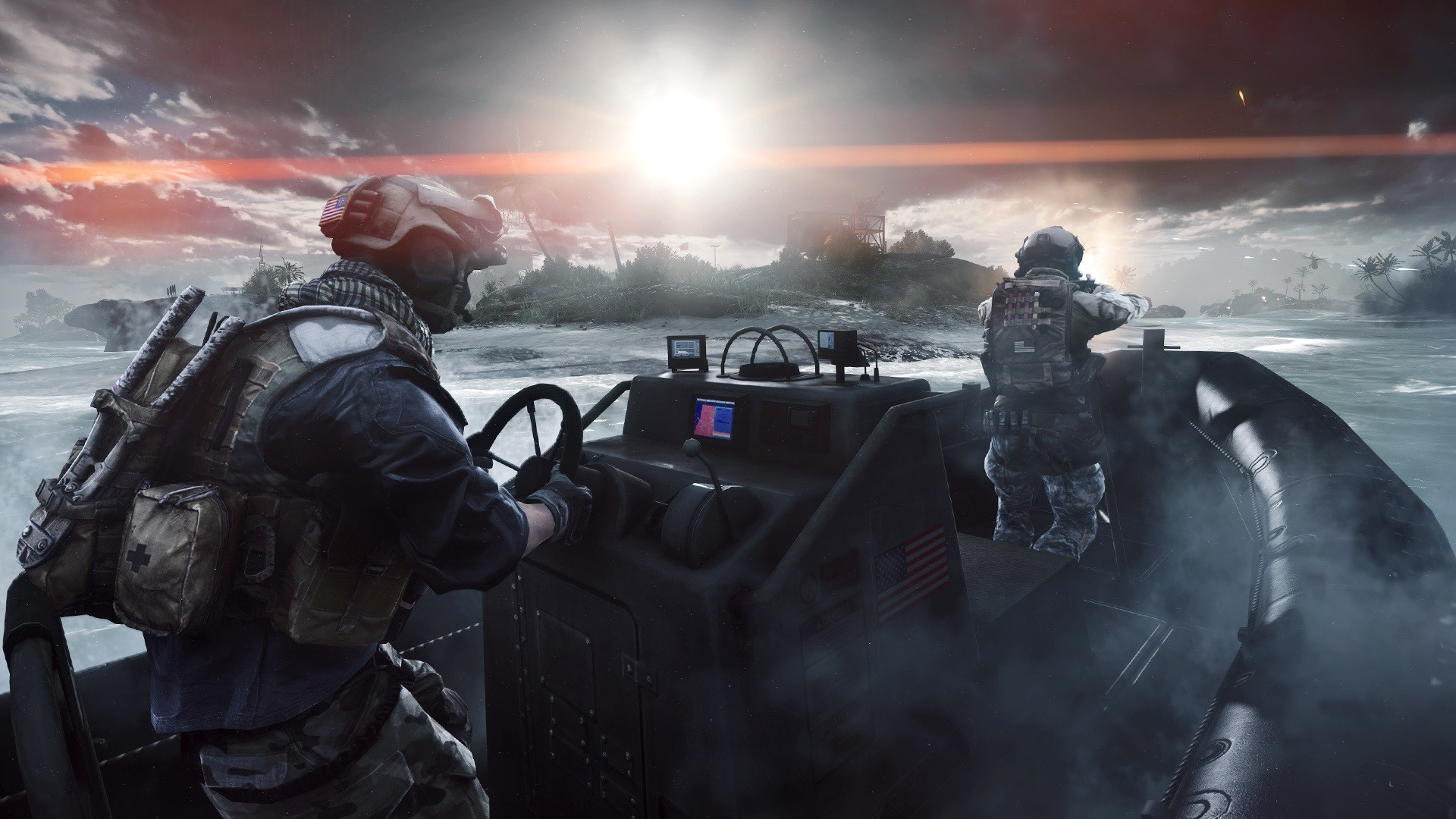
Combat in Battlefield 4’s multiplayer component is both strong and satisfying. The PC and current gen versions of the game are far more fleshed out than their PS3 and 360 brethren with full 64 player matches in Conquest mode compared to the last gen’s much more humble 24 player limit. This, in turn, yields a much more frantic and, consequently, a match-to-match experience that feels far more involved and alive. Whereas I felt like a valued member of my team in the last gen versions, though my role in diminished somewhat with a near tripling of the player count, I still feel like a can be a critical squadmate. Nowhere throughout my dozens of hours of play across the various modes of the game did I feel fatigued or stressed to the point of quitting in a huff. I have enjoyed my time immensely and will continue to do so in the months to come.
Objectively I have to say that the map design in Battlefield 4 feels like a hit or miss depending on the mode selected. Across the ten maps that ship with the game (eight additional maps are now available through DLC depending on your platform of choice) you will find interesting ones very befitting to most of the gametypes like Siege of Shanghai, Paracel Storm and Operation Locker while others are definitely more geared toward the series’ most popular gametype Conquest. At this current point in time DICE is still working on spawn times and vehicle placement on some maps such as Hainan Resort’s Rush progression but it is clear that they want to make the experience better.
One big point that DICE and EA have been quick to talk up is their concept of ‘Levelution’ in which player actions can change the way a map is played. Sadly though, other than Siege of Shanghai’s famous skyscraper takedown, most of the other maps either feature a much weaker map event. Paracel Storm gives us pretty if somewhat ineffectual typhoon and Flood Zone takes out most of the ground level traversal save for those who have the patience to swim but not many others hold the same excitement or dynamic changing event that alters the way you have to play. Some don’t even feature one such as Golmud Railway or are so mundane that they happen and you simply go back to what you were doing ten seconds later. This large scale, gameplay shifting destruction sounds great on paper but, thus far, is not indicative of what players would expect or want to see in a level.
One very welcome returning feature of the game is the Commander mode, an RTS-like gameplay element that was last seen in Battlefield 2142 back in 2006. Rather than taking to the field, the commander get a top-down view of the entire map and has the capacity to send and receive orders as well as send support to players on the ground by way of radar-enhancing UAV drones and resupply drops. Based on the progress of your team in certain modes such as Conquest, additional offensive powers could be granted to you such as the ability to deploy a gunship or launch a cruise missile strike. The player has to be wary and anticipate the actions of the enemy commander though as balance tweaks allow opposing players to block out each other’s commands or warn their troops of other shenanigans their opponent may be doing. It’s very nice to see this feature finally return is perfect for those who want to participate but don’t actually want to do any shooting at the moment. Of all the tablet-friendly second screen apps and modes available to consumers at the moment, Battlefield 4’s commander mode seems to be the best of the bunch.
All in all, where the singleplayer fails, the multiplayer makes up for in strides.
In The Pipe, 5x5
As a transitional title designed to bridge the gap between last generation and this new one, Battlefield 4 definitely makes it as one of the visual standouts as to the potential of what our new systems are capable of. Whereas the last gen versions demonstrate muddy textures, questionable lighting schemes and foliage that can look like a cardboard cutout at times, the PC and next gen versions are visually outstanding. There are some subtle signs unconformity between the PS4, PC and Xbox One versions (with the Xbox One version depicted here) but the end result is a rather nice 60fps game with very few framerate drops, great foliage and particle effects that will get you killed in a firefight for staring in awe for too long.
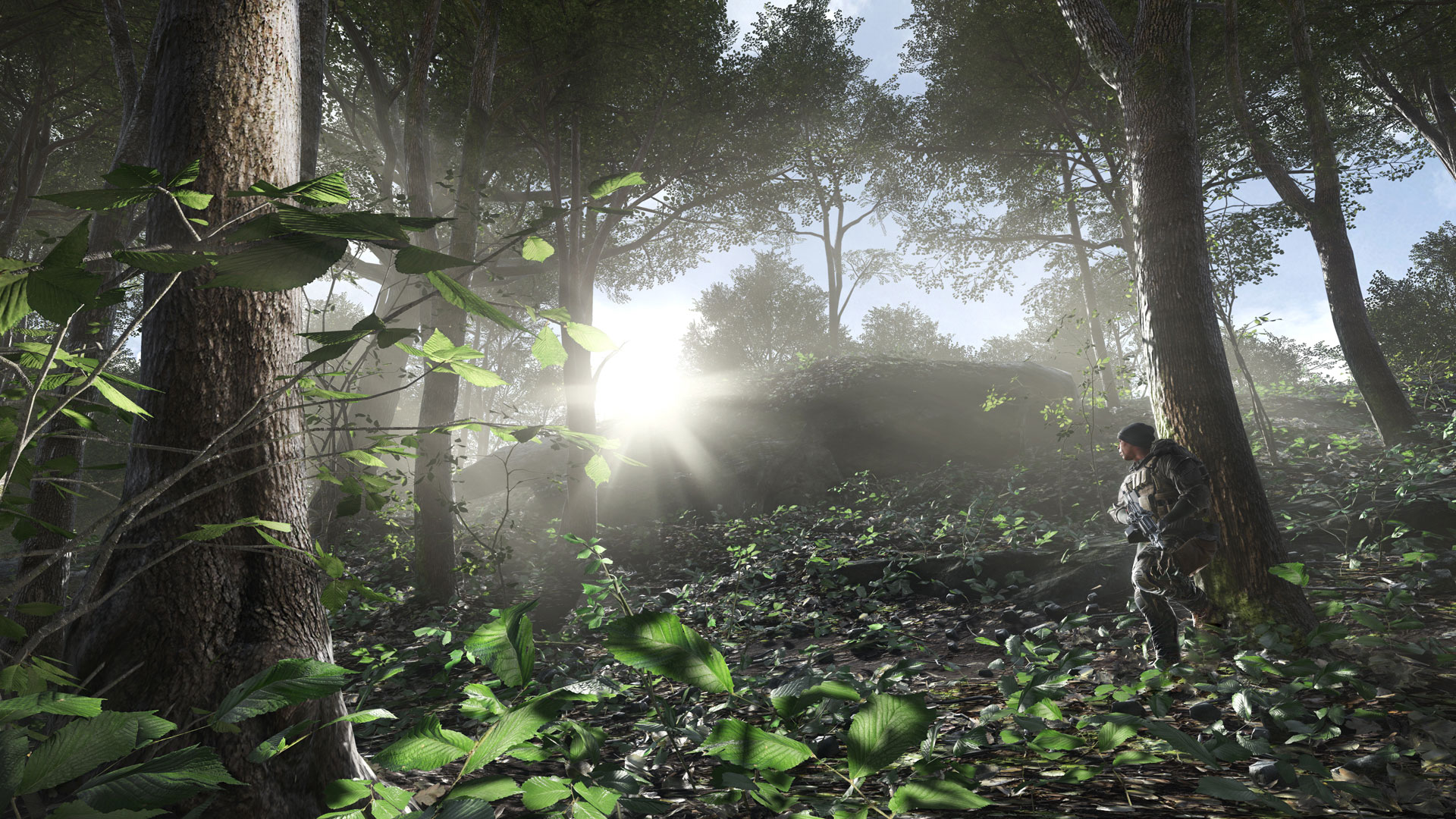
As a transition title though, beyond the visual design, it is also a primer for what the systems can really support in terms of gameplay. Last gen versions of the games limit matches to, at most, 24 players whereas the PC and current gen versions allow you a proper 64-players, something rarely achieved let alone balanced properly on the console scene up until now. The transition one can observe in one game between whole generations is quite startling and Battlefield 4 does an outstanding job of telling us just what we can expect going forward.
Baring the decidedly phoned-in voice acting for the singleplayer, Battlefield 4’s sound design is just as fantastic as the visual presentation. Localized sound is great and the audioscaping for the variety of environments you will encounter are quite splendid. While it can be a bit hard from a distance to get a sense for the weapons that are being fired, no two weapons seem to depict a uniform sound effect set when you are pulling the trigger. Hearing a jet go whizzing past you overhead as the tank that’s been chasing you explodes into fiery shrapnel is intense and really lends to sell the fact that this game isn’t about just localized deathmatchs: you are part of a larger, overall effort that won’t be over in ten minutes. It’s not a question of fights between squads: it is a battle between whole armies. And this is why Battlefield is such a good series.
With all this being said however, Battlefield 4 has seen one of the most turbulent launches in recent memory. Fraught with bugs, server issues and crashes across all platforms, it is quite clear that Battlefield 4 wasn’t meant to be released on October 29th. Given another two to three months of work DICE clearly could have put together a stellar multiplayer suite but, when a game outright refuses to connect you to a match and the server browser is completely broken, you should know you have a problem that needs to be addressed immediately. That being said, over a month now after release, DICE is still combating problems on all fronts. New waves of patches seem to be coming weekly but this doesn’t help the millions of people who have bought the game expecting greatness only to constantly receive time out error messages. DICE will most certainly fixes these problems over the next few weeks now that all versions of the game are now available at retail but that hasn’t helped the stigma Battlefield 4 has endured and will continue to plague it for some time to come.
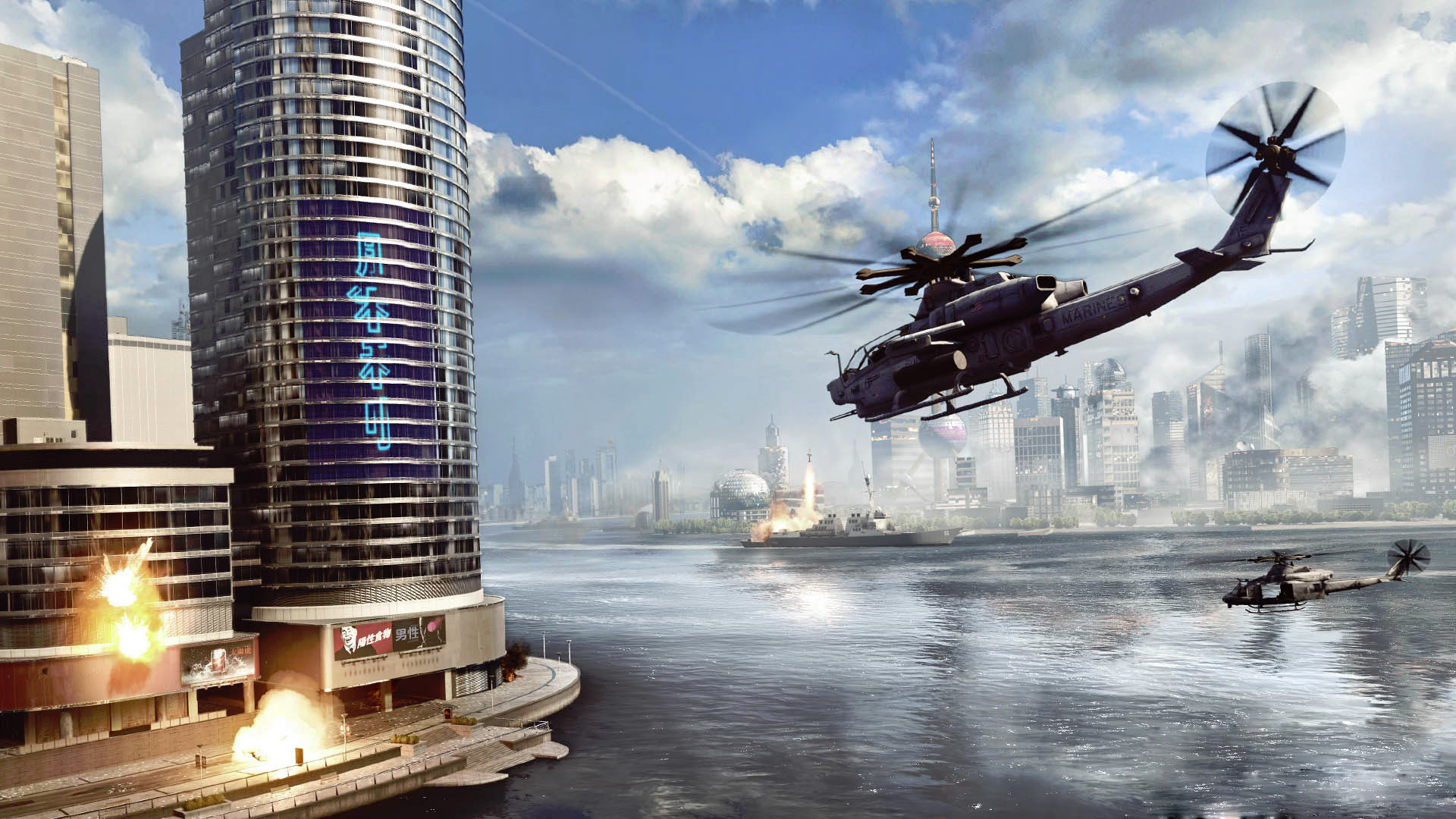
The War at Home
As much as I love Battlefield 4 it is certainly a game that wasn’t ready to be released. Its singleplayer component lacks any sort of excitement or emotional punch to make it anything but a drag to play through thanks to a poorly written story and even worse characters. Its multiplayer makes up for much of that problem and when it wants to work it is a tremendously satisfying experience. However, games should work when we want to play, not the other way around and thanks to a bug-laden launch, it has been a disappointment.
Battlefield 4 is not the impressive leap forward that it was between the second and third numbered titles. Instead, this is Battlefield 3.5, a refinement of the basics that we got in 2011 with some impressive scripted destruction and gameplay balancing that changes the way you play. Its campaign is crap and a waste of your time but, when it works, the multiplayer is some of the best on the market.
 Review,
Review,  Video Review,
Video Review,  Xbox One
Xbox One Review: Splinter Cell Blacklist
 Tuesday, August 27, 2013 at 10:00AM
Tuesday, August 27, 2013 at 10:00AM There was a time in which the name in the stealth game genre was Hideo Kojima’s epic series Metal Gear Solid. Solid Snake and his entourage of strange characters and towering mechs saw occasional competitors in games like Tenchu and Thief but it wasn’t until Ubisoft threw their hat in the ring with Tom Clancy’s Splinter Cell in 2002 in which the gigantic Japanese franchise would really have a challenger to the throne. Over the years the Splinter Cell series has grown in ways both exciting and unexpected, with 2007’s Double Agent marking the end of the traditional formula and 2010’s Conviction ushering in a more action-oriented one.
Conviction however became the most polarizing title of the series and though its more personal story approach was appreciated, many lamented the kill-everyone-and-move-on gameplay that permeated most of the experience. Ubisoft seems to have taken this fan feedback to heart and this year has brought us Blacklist, a seemingly more balanced “greatest hits” take on the variety of gameplay formulas across the 11 years of this series’ existence.
Are these changes enough to save Splinter Cell from a spiraling downfall and becoming the next Resident Evil?
Click to read the full written review
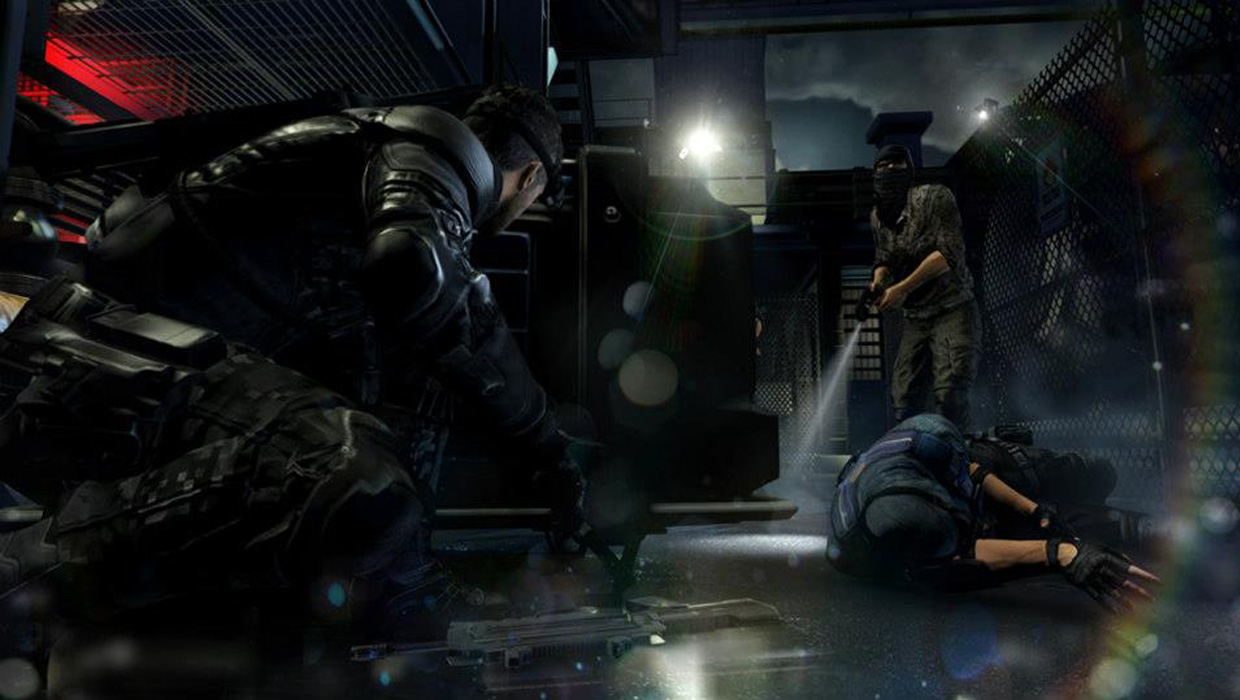
Back in Urban Gray Camouflage (Black)
Several months after the devastating EMP attack on Washington DC by Tom Reed’s corrupt Third Echelon, former Splinter Cell Sam Fisher is still trying to figure out his future. He’s reconnected with his daughter, Sarah, after having one another’s deaths falsified by Irving Lambert, and has joined up with friend Victor Coste’s Paladin 9 private security firm. On a routine trip to Guam, Sam and Vic are caught up in a massive terrorist attack, one that devastates Anderson Air Force Base. Vic is hurt in the attack and Sam and their tech advisor Charlie Cole are barely able to make it out alive.
Shortly thereafter a group known as the Engineers claim responsibility, promising a series of even more devastating attacks every seven days until America withdraws their troops from abroad. In response, US President Caldwell, remembering Sam’s rescue of her during Conviction, approaches Fisher with an offer: complete authority over a new Fourth Echelon initiative only answering to her. Together with series ally Anna “Grim” Grimsdottir, Charile and new recruit Isaac Briggs, Sam must hunt down the Engineers before they are able to complete their deadly countdown.
In many ways, Splinter Cell Blacklist attempts to bring us a story focused on a renewed Sam Fisher and a revitalized, more basic Echelon initiative. Fourth Echelon has the authority to utilize the Fifth Freedom at any given time but is able to act independently, making them far more mobile and thus allowing Sam and crew to take on missions that otherwise wouldn’t happen. This also provides an opportunity to reintroduce us to characters from the previous games as well as bring in new ones. It is here that, from a character standpoint, Blacklist falters.
Sam is easily the biggest victim of this. Splinter Cell Conviction’s story was focused far more significantly on him and his search for Sarah in proportion to how much of the story was center around Third Echelon’s attack on Washington DC. Instead of giving us a more character-driven narrative, Ubisoft has instead pushed his character back to what he was like pre-Conviction: a trained operative with drive but less personality. Elements of Sam’s character remain intact such as his fatherly bond with Sarah but anything more is not really explored. Heck, in this area it seems that Ubisoft skewed its focus a bit, forgiving Anna for faking Sarah’s death which resulted in a self-destructive three year period in Sam’s life, as opposed to his hatred of Andriy Kobin for providing the false body that Anna and Lambert used for said deed. It’s confusing as to why Ubisoft would avoid character development for Sam Fisher when the entire previous game was about just that and, ultimately, I found that to be quite disappointing.
The other primary characters don’t receive proper attention like they should for a series six games in. Anna remains the same do-what-is-necessary hardliner, Charlie is the resident tech geek, Isaac is the eager but green newbie and Kobin is the antagonistic yet entertaining “bad guy”. Everyone fill an archetype role and there is next to no growth between the whole lot. People might ask why I care but given just how much goes into creating this universe that spans six games and novels a piece you would expect there to be changes, especially with the shift in narrative Conviction brought.
Not that this story is meant to bring a focus more on any sort of character development. Instead, Ubisoft’s presentation of Blacklist is focused more on in-the-moment storytelling than grand plot development, giving us a story that links back-to-back levels together rather than spinning a massive web of conspiracy. It’s unfortunately par for the course as a Tom Clancy title rather than the exception. The story will entertain you but it probably won’t be winning any awards, least of all it being all that memorable six months to a year down the road.
Panther is on the Move
Splinter Cell has changed significantly since the 2005 title Chaos Theory in many ways but nowhere is this more prevalent than in the design and gameplay changes. Many, including Ubisoft, have likened Splinter Cell Blacklist to that of a sort of “greatest hits” amalgamation of everything that made the previous installments such interesting titles. I find that I have to agree with this sentiment.
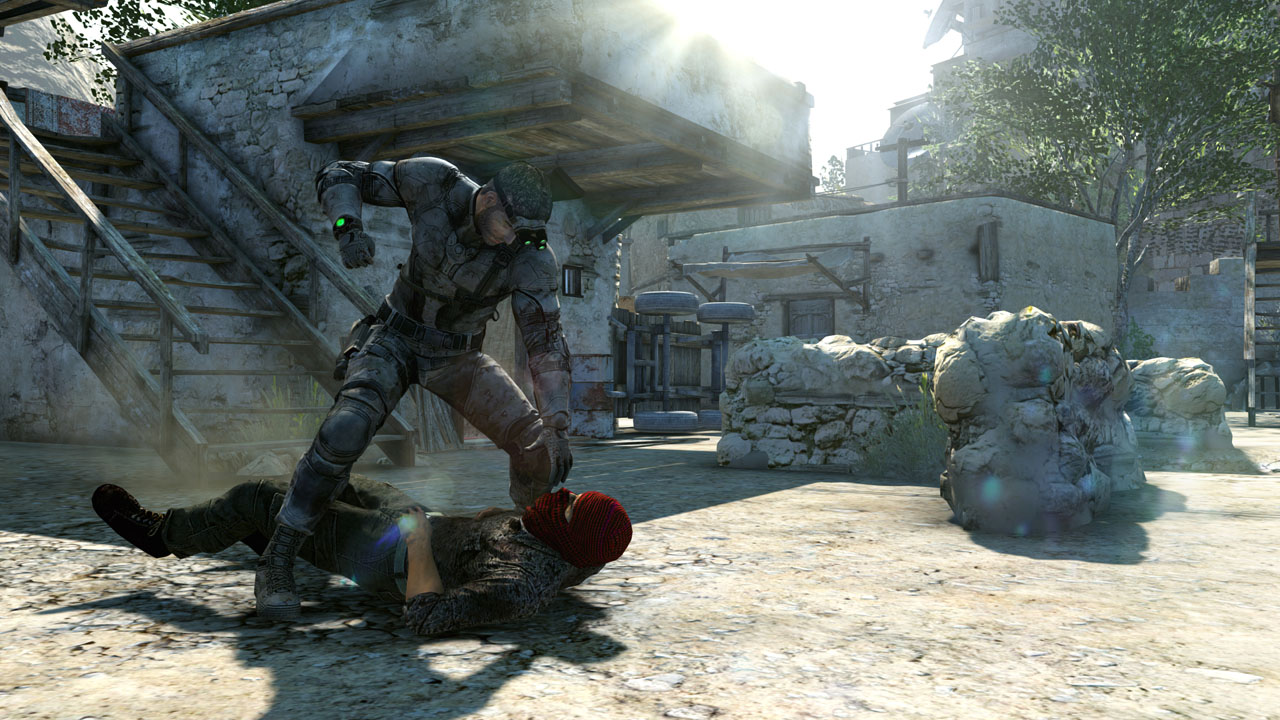
In its most basic sense, Blacklist is the spawn of the marriage of two vastly different Splinter Cell titles: Chaos Theory and Conviction. Returning is the time-honored focus of sneaking through an environment avoiding enemies and engaging in combat as little as possible. This is combined however with Conviction’s much faster pace, creating a far more rapid sense of level traversal and, thus, a much more mobile main character. Despite his age, Sam feels exceptionally agile for a field operative, much less one tasked with such an important mission as stopping the Blacklist. This combination is simply the best of both worlds and balances out just how powerful Sam was in Conviction with how vulnerable he could be in the original titles.
In fact, many of the issues people had with Conviction seem to have been addressed. Our hero is no longer forced to kill everyone in sight as he was in almost all of Conviction and it is in fact possible to beat the game without Sam killing anyone. In addition many of the maps present are both large and open ended, allowing for multiple approaches and play styles. Enemy AI has also seen a dramatic improvement, offering more intricate and random search patterns looking for intruders as well as the reintroduction of guard dogs that will hunt the player down if they are not cautious. It definitely feels like it wants to be a slower experience and Blacklist in fact can be depending on your preferred game methodology.
Splinter Cell Blacklist isn’t all old hat however as many new systems have been introduced or revitalized. Conviction’s somewhat overpowered Mark and Execute still works albeit limiting the player to just three marked targets. Putting an emphasis on Sam’s more predatory nature, Blacklist has also introduced an abduction system for easier melee access to enemies. Hiding behind an object or doorway, Sam can grab passing enemies and immediately knock them out or kill them with the press of a button. Sam can also immediately takedown an enemy from almost any angle in a rather fluid and rapid manner this time around so long as he hasn’t been spotted, the sole exception being armored enemies that can only be taken down from behind.
Side missions are another new addition to the game. Though not contributing to the overall plot in any significant way, side missions can still be quite fun to play through for those wanting a singleplayer experience without having to sit through cutscenes. Each of your principle cast will have their own set of missions you can take on with Grim offering ghost missions, Kobin with terrorist hunts, Charlie with wave survival matches (something that feels almost impossible for those looking to do no-kill runs) and Briggs with strictly co-op oriented missions. You can also replay these missions at any time should you choose to.
Ubisoft has also introduced a new scoring system that adapts to the way players approach the game whether it be ghosting, full assault or a combination of the two known as Panther. Despite rewarding points and grading you based on each play style, Blacklist properly emphasizes stealth gameplay over anything else, rewarding higher points for sneakier actions with the highest possible payout going to avoiding all enemies in an area entirely without being detected. It is a subtle way to enforce being stealthy in a game about doing just that and I have to compliment Ubisoft on implementing such a system. Who knows, maybe we’ll get a few converts from the FPS crowd.
Tying into this scoring system is a revitalized emphasis on cross-mode currency. In singleplayer you receive a multiplier effect to your score which, when totaled, equals the amount of money you are rewarded per mission. The multiplier goes up the more missions you take on so side missions are key to earning you higher rewards. This currency, in turn, can be spent on upgrading your equipment and characters across singleplayer and multiplayer but more on that in a moment.
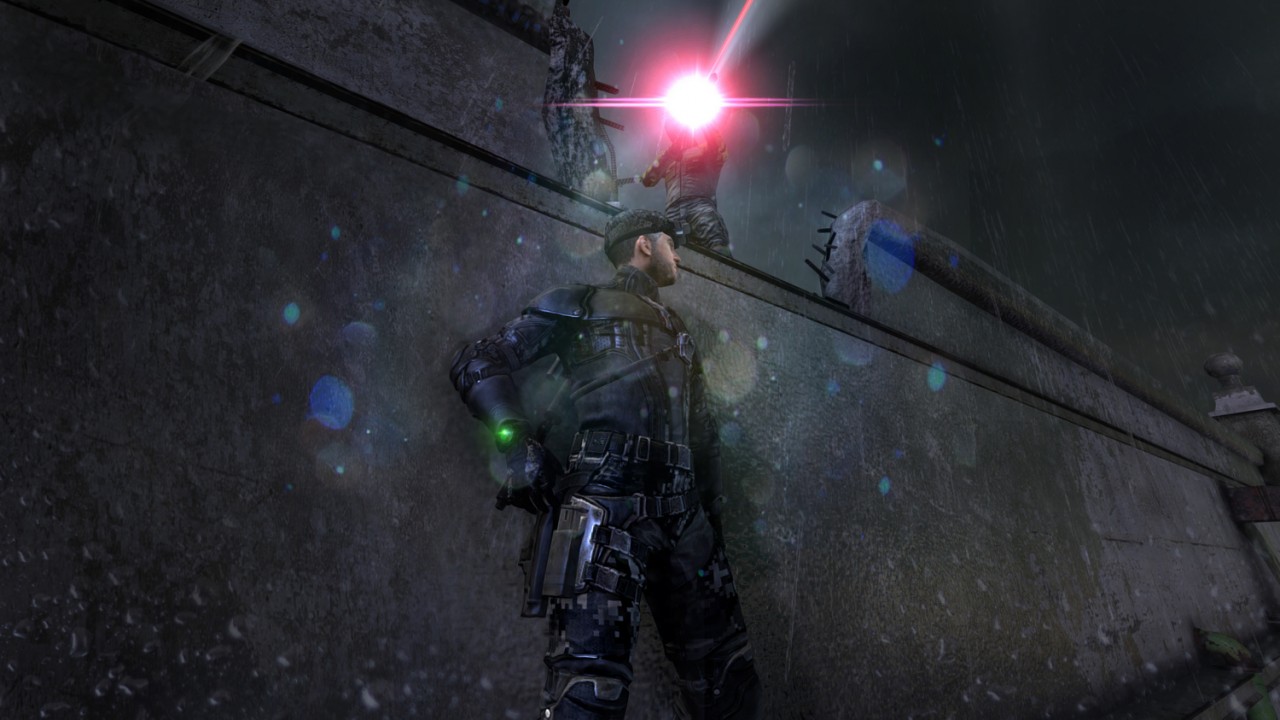
One of the more interesting aspects of the game is something that might surprise fans of the Mass Effect series: your headquarters. Much like the Normandy, Fourth Echelon is run out of The Paladin, a massive airship that allows Sam and the crew to remain mobile and to quickly react to terrorist threats. The player, as Sam, can freely move about Paladin to interact with the principle cast and unlock concept art and the like. This is also the only point in which you can make contact with Sarah Fisher which is disappointing since you only hear her but never actually see her. Don’t expect to have any profound conversations between your crewmates either but it’s definitely a lot nicer than only seeing them in cutscenes and hearing them in your ears.
One final item I simply must point out is the game’s Perfectionist mode. Splinter Cell veterans who were disappointed with the direction Conviction took will be pleased to hear that Perfectionist reverts many of the classic Splinter Cell rules to those much earlier titles. Sonar goggles do not work, targets can be marked but not executed, combat is extremely difficult to survive and you cannot restock your items mid-mission. These seemingly simple restrictions completely change the way you would otherwise play Blacklist and offers a level of challenge that should definitely be experienced by stealth game fans. If you consider yourself a Splinter Cell fan, you are doing yourself a disservice by not playing this difficulty.
Death From the Shadows
The singleplayer aside, Splinter Cell Blacklist offers a fine multiplayer suite to experience and man, am I ever glad to say that what is offered is very, very good. Co-op missions return from Conviction with a storyline running parallel to the main story focusing on Voron, the Russian equivalent agency to Third Echelon. These missions are quite fun to be sure but a single runthrough of them all is all you need to experience with them. No, the true highlight of this suite is the long-awaited return of Spies Vs. Mercenaries competitive multiplayer and I have to say that it is the best online mode of any of the games to arrive this year.
Spies Vs. Mercs has been a long time coming and many Splinter Cell fans will argue that this is the first true-to-form SvM experience since Chaos Theory in 2005. Like the effort Ubisoft put into balancing out Blacklist’s old-and-new gameplay styles, the multiplayer has taken what was best about Pandora Tomorrow and Chaos Theory’s 2v2 action and updated many systems and level design to facilitate a much more expanded experience. For core fans who were upset about how poorly implemented SvM was with Double Agent, you have absolutely nothing to worry about.
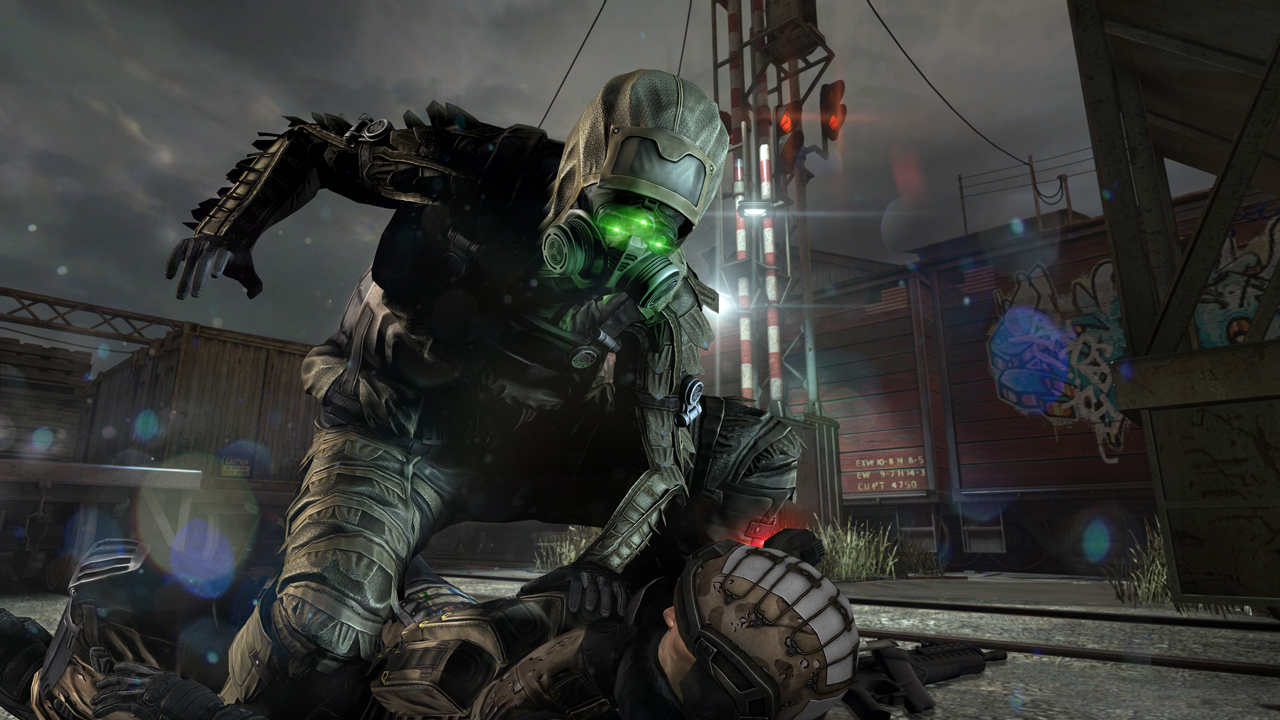
Competitive multiplayer is divided among five different modes: Classic, Blacklist, Uplink Control, Extraction and, well, it wouldn’t be an online multiplayer game with Team Deathmatch, now would it? The concept for Spies Vs. Mercs is actually quite simple: one team plays as vulnerable yet very agile spies from a third person perspective while the other plays as heavily armed yet slow mercenaries from a first person perspective. For the first two modes, mercs must prevent terminals placed throughout the map from being hacked by spies. Once a round is over the teams switch sides and play again. Players rank up based on their performance and earn cash and tokens to unlock or upgrade their gear.
For the purists like me, SvM Classic is the absolute best way to play. This 2v2 mode harkens back to the early days of Splinter Cell multiplayer. Customized classes for both sides cannot be used and instead you are limited to a few key items that were previously featured in the earlier games. Levels have also been relit to emphasize shadows and exploration with the mercs armed with a flashlight and the spies only having access to night vision. These limitations coupled with the redesigned light maps make for incredibly tense experiences that will induce paranoia in both teams. There’s nothing quite like hanging off a railing as a spy, scared to death of a merc flashlight slowly moving its way toward you, its beams of illumination surely to be followed by bullets if you get spotted. It is an intense, fun experience and one I feel that seeps into my soul, begging me to go back and play it any hour of the day.
Blacklist mode offers the same experience albeit in a 4v4 setting. Despite my fear that a 4v4 gameplay style would negate any though of stealth gameplay and oriented it to a more action focus, SvM Blacklist does a surprisingly good job of playing hide-and-seek in an enjoyable manner. New vision modes and character class bonuses make this very team-oriented and discourages playing as a lone wolf. Though the maps are brighter than their Classic counterparts but since the mercs are not given access to a flashlight and instead must rely on alternative gadgets such as sound and motion detectors, both teams feel balanced enough to make gameplay quite engaging for both sides.
Beyond the main modes, Spies Vs. Mercs offers different experiences that you will want to build unique classes for. Extraction tasks a team of mercenaries with stealing a briefcase from the spies in a manner evocative of a one-sided capture the flag match. Uplink Control plays similar to a king of the hill match in which each side vies to secure a certain point on the map. And, well, Team Deathmatch is exactly what you think it is. One thing that should be pointed out is that Team Deathmatch and Uplink Control allow teams to mix and match spies and mercenaries, allowing for some very interesting team balancing opportunities.
Spies Vs. Mercs could have been terribly unbalanced had Blacklist shipped with only generic map design but I’m glad I can report that the six maps available at launch are all unique and interesting. Mercenaries have access to all of the major points on the map but spies have exclusive access to vent shafts and hidden pathes. Particle Accelerator, for example, has a network of upper walkways only spies can access. The map design also takes into account spawn points, with Lebanese Hospital for example starting the spies off on the roof with immediate fast rope options to the lobby below where one of the terminals await. One can only imagine what Ubisoft has cooking for downloadable content at this point. Who knows, maybe the return of classic maps such as DefTech, River Mall, Orphanage, Bank or more? I sincerely hope so.
In short, Spies Vs. Mercs’s triumphant return is something that should be celebrated. In an age in which the only stealth-based multiplayer we can get involves avoiding idiots running around on rooftops with hidden blades in Assassin’s Creed, it is wonderful to see such an inviting and exciting experience appear. Long live the king.
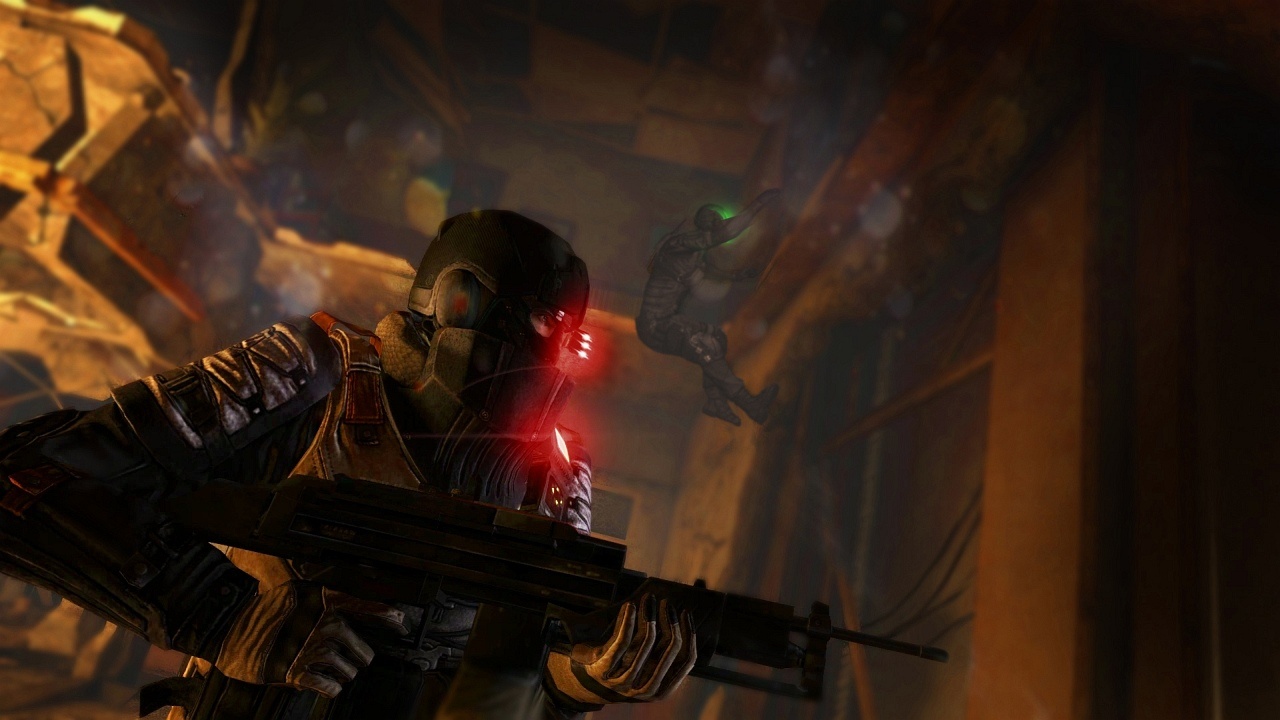
Changing of the Guard
The final year of a console generation tends to yield the best looking titles a system can provide and, in some respects Splinter Cell Blacklist fits this description. Character animations are very nicely done with cutscenes rendering some tense moments. Sam’s takedowns in particular will ‘wow’ you at times both for the intricacy that goes into the move as well as the sheer brutality. If the sort of mocap while acting seen in games such as Enslaved and Blacklist are the future, I look forward to what the future has in store.
Despite that, there are some issues that must be pointed out. This review being based on the 360 version of the game, textures do look quite a bit muddled at times. Character faces lack some animation at times and often are missing emotional depth in comparison to the voice and body movements depict. Lighting can be a bit inconsistent at times as well as, for example, the player should be blinded when utilizing night vision in a well-lit environment. This does not happen sometimes and is most confusing.
The music department needs some work in my opinion as well. Gone are almost all of the orchestral scores done in Conviction save for the core Conviction theme which is mainly used when Sam is on the phone with Sarah. Michael McCann, famous for his work on the Deus Ex Human Revolution, brings us a more synthesized, digital soundtrack but what has been brought to the table doesn’t seem to be nearly as strong as the work put into that or last year’s XCOM: Enemy Unknown. McCann was also responsible for the Splinter Cell Double Agent soundtrack but none of that depth or excitement seems to be present in Blacklist. It’s par for the course honestly and doesn’t seem to be worth your cash listening to outside of the game.
The most egregious error Ubisoft has made is also the most obvious one and I cannot begin to close things out without addressing it: the voice acting changes. Save for a few key cast members such as Andriy Kobin and Victor Coste, the primary voice cast has completely changed this time around. Anna Grimsdottir was previously voiced by Claudia Besso but she has since been replaced for Blacklist by Kate Drummond whose acting experience has been limited to bit parts and the occasional made for tv movie. This isn’t the worst of it though.
Sam Fisher, long voiced by experienced actor Michael Ironside, has been replaced by Eric Johnson, a recent actor known for his work on television shows such as Criminal Minds. This change is a stark contrast to say the least and will jar anyone who has ever experienced any of the Splinter Cell games. The transition from an older voice to that of a much younger one simply doesn’t make sense for a character that has long been touted as a more season, older operator, something that Ubisoft was quick to tout in the early years of Splinter Cell when having to compete with the Metal Gear franchise. Ironside himself is only a few years older than Sam Fisher is supposed to be and Johnson’s presentation neither makes sense for the character nor feels proper. David Hayter being replaced by Kiefer Sutherland is something I can understand since the character of Big Boss has aged considerably and has experienced scarring and battle fatigue as the Metal Gear series has gone on. Ironside being replaced Johnson simply does not match up with what anyone should imagine Sam Fisher to be. It is a terrible decision in my opinion and should definitely be re-evaluated when the next title comes out in a few years. Ubisoft claims that this decision was made because they wanted to do the kind of voice acting during mocap sessions I spoke of earlier. In this regard, I simply don’t understand why Ubisoft couldn’t just put his voice in in post-production. Get your act together, Ubisoft. Sam Fisher is Michael Ironside, end of discussion.
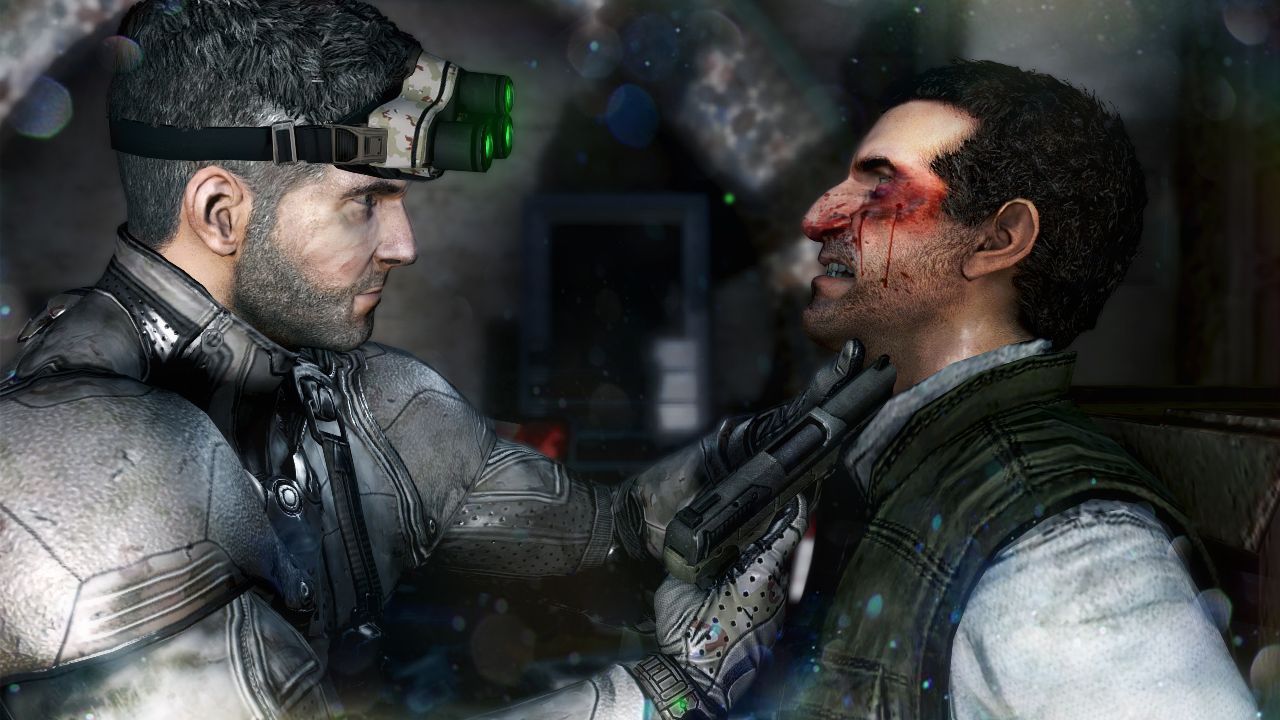
A War Fought in the Dark
Splinter Cell may be but a decade old at this point but despite years of trends such as the rise of the competitive FPS or MOBA, it has stayed relatively true to its formula save for 2010’s Conviction. Blacklist may fail in the story department but its balancing of classic, more methodical stealth gameplay with faster pacing seen in more modern design yields a very exciting amalgamation across all three gameplay modes. The singleplayer may disappoint but the multiplayer offerings more than make up for it with Spies Vs. Mercs almost feeling like it is worthy of being a standalone product. The change of voice for Sam is still at the very least lamentable but it shouldn’t be nearly enough to deter you from having a sold experience with the game.
Ubisoft felt that Splinter Cell needed a revamping with 2010’s Conviction and many disagreed. Blacklist serves as a balancing act between where they wanted to take the franchise and what series fans loved and wanted and the result is one of the best Splinter Cell experiences to date, just shy in my opinion of the stellar Chaos Theory. It’s a return to form and one that I hope will be the benchmark for the series going forward.
 Review,
Review,  Video Review,
Video Review,  Xbox 360
Xbox 360 E3 2013 Coverage
 Monday, June 24, 2013 at 9:00AM
Monday, June 24, 2013 at 9:00AM Here, for your consideration, is all the video work I did for 4Player Network during E3. It's not as much as I wanted to do but hey, we did quite a bit even still.
A new musing coming Monday afternoon. Stay tuned.
Oh, and sorry for being quiet. I'll see about rectifying that in the future.



I don’t think there is anyone in the world that can reasonably argue that Call of Duty isn’t the biggest shooter franchise on the market right now. Its solid foundation of twitch-based combat, powerful killstreak rewards and variety of weapons makes a go-to series for competitive FPS players. However, as the years have gone by, the annualized franchise has begun to show its age and challengers such as Battlefield have really begun to offer alternatives for those looking for a different experience. Titanfall, the first product from the newly formed Respawn Entertainment, hopes to fit that bill.
Born from a dispute with publisher Activision over bonus payouts after the release of Modern Warfare 2, Respawn, created by Infinity Ward founders Jason West and Vince Zampalla alongside a quarter of the core IW team, has stuck to their roots in creating a twitch-based FPS while bringing combat out of the modern setting and into a scifi, almost Firefly-esque, future battlefield. With Call of Duty behind them and, ironically, their biggest competitor, does Titanfall have what it takes to change the way we think about the competitive shooter?
You Can’t Take the Sky From Me
Centuries after humanity has spread to the stars, our species has found itself settling on two sets of planets: the Core systems, the first life-bearing bodies we found, and the Frontier, a newer set of systems full of untapped resources that we are still attempting to colonize. Between the two lies a vast expanse of space for which nothing exists. From the Core systems, the Interstellar Manufacturing Corporation, a commercial empire that controls the vast majority of the shipping lanes and planetary contracts, rules the Frontier, imposing their will as they see fit and legally backing up their claims with armed incursions. Opposed to them are the Militia, a mishmash of homesteads, colonies, mercenaries and more that aim to kick the IMC out of the Frontier.
Titanfall stands as a multiplayer-only game from the outset though the setup for the game’s universe that you just read is still applicable thanks to the inclusion of Campaign Multiplayer. As one of the primary gameplay settings, Campaign Multiplayer takes you on a narrative-focused playthrough of a series of nine maps from both the Militia and IMC perspectives. Each map begins with a scripted intro sequence for which you are introduced to the battlefield you are about to engage the enemy in as well as multiple in-game events that occur at set moments as the match progresses.
Sadly, apart from the intro cutscenes, very little of the game makes an effort to draw you into the story, let alone make you feel for the characters on either side of the conflict. We are not given a proper introduction to pretty much anyone nor do you receive any in-game information as to why this war is happening. Respawn has clearly put a lot of time and effort into this game over its three year development stretch but it doesn’t seem as if they’ve made that strong an effort in making the universe one that the player should care about. At no point throughout either side of the campaign did I feel any emotions for the game’s characters and that’s strange to me considering that Respawn clearly wants to build a franchise.
What’s even stranger is just how the campaign for the game is formatted in terms of gameplay. Apart from only playing two of the five different gameplay modes, the win/loss conditions of each match have almost no impact on the outcome of the narrative save for how the characters address the results of the battle. Instead, the storyline never changes or adapts to what the player has accomplished with, spoiler alert, the good guys winning and the bad guys ending up on the run. This could have been an excellent opportunity for Respawn to introduce gameplay elements such as branching narrative design, story-focused sub-mission objectives and progressively changing mission conditions. Based on the outcome of a match, why couldn’t the follow-up match include bonus conditions for each team? If the winning team earned a sizeable percentage of points over the losers, why can’t they, for example, receive an extra compliment of AI companions in the next match? Or, for that matter, why not take a page out of Black Ops 2’s branching narrative design and craft us a custom-made story based on player actions? All of this can, of course, be chalked up to a small development team with a finite amount of resources at their disposal but even so, this feels like a lost opportunity.
Despite the road not taken with the overall design of the narrative elements, Respawn has stayed true to their origins in creating setpiece moments throughout the match. Both the skybox as well as various places on the map will show off in-game events that, for the most part, are out of the player’s control and demonstrate an almost living, breathing battlefield. One such map can feature an aerial battle between several capital ships while another features “dragons” that can attack AI grunts. Two memorable matches include a D-day-esque storming of the beaches moment as an AI Titan leads you and your troops into battle while yet another features gigantic, lumbering dinosaurs just outside the walls of your map. Yes, you read that right: Titanfall has dinosaurs in it. And that’s awesome.
All in all, though Titanfall lacks punch in the delivery of their core narrative and universe build-up, the campaign’s definitely fun to playthrough for at least the first time. It should be noted however that the player does not gain access to two of the game’s three Titan models, the Strider and the Ogre, unless they complete the campaign as both the Militia and the IMC. Don’t worry about it taking too long though since it only takes about an hour and a half to complete a campaign through to the end thanks to just how fast the game’s matches go. It’s a fun romp while it lasts though one would hope that the game’s upcoming DLC will address the issues I’ve mentioned above.
Look Out Below
Though Titanfall’s attempt at introducing narrative into a multiplayer game ends up being about on par with what Splash Damage’s 2011 title Brink did, Titanfall succeeds in the gameplay department in strides. Beyond just the story, the comparison I just mentioned is a necessity when one brings up the game’s parkour movement system and unlike the lackluster attempt Brink brought to the table, Respawn’s title is quite the feat. Nay, I say, it’s one of the best parts of Titanfall.
Built on the same foundation as any other shooter, Titanfall harkens back to the olden days of yore when Quake and Unreal Tournament were the biggest names in competitive gaming by giving the player a jetpack for which the player, at any time during a jump, can induce a double jump that aids both vertically and horizontally. This is combined with the ability to, while in the air, run along walls by simply pushing up against one. Running along a wall yields a faster rate of movement than traveling on foot, encouraging this behavior. This is all well and good but the real ticket comes when you take notice that the jetpack resets its boost every time your feet hit a surface. This means that, if one is careful, they can chain wall runs almost infinitely so long as they can maintain the necessary momentum to initiate one. The end result is tremendous fun and while it has some very negative consequences to your ability to aim your weapon, it will end up being the best Titanfall players’ method of choice for getting around the map.
The movement system wouldn’t be strong however unless Respawn emphasized complimentary map design and, for the most part, Titanfall’s initial offering of 15 maps makes parkour exceptionally satisfying to do. Though not every single one of them does so, the selection at hand does a very nice job of both encouraging extended wall running and parkour thanks to corridors and well placed geometry while offering larges spaces by which titans can engage in mass combat. One excellent example is Rise, a pit-esque map with tall, rising walls and interconnected hallways. Rise seems to be the ultimate example of the game’s parkour possibilities as you can stream wall runs so long that you can actually climb high enough to get out of the map.
The omega to the wall running system’s alpha are the Titans, the titular object of both everyone’s desire and bane throughout the Titanfall experience. These 20ft tall mechs are illustriously exciting to utilize at times and an essential tool for combat throughout the game. Unlike the typical killstreak or power up you get in most other twitch-based shooters, players are all given a Titan after a certain amount of time as indicated on your HUD. This timer can be cut down significantly if the player is able to damage or kill enemies with the most cut time rewarded for killing opposing players. This system ensures that even the most novice of players will still earn a Titan at least once through the course of a match, something that players in games like Call of Duty may find trouble with especially later in the game’s lifecycle. Skilled players will be able to earn upwards of four or five Titans during a match but it is a very fair system and is a most welcoming inclusion to the formula.
Titans come in one of three flavors though you only have access to one of them unless you complete the campaign as both the IMC and the Militia. The Ogre is your heavy mech that is able to hold its own in most fights while the Strider is light weight and won’t though it is uniquely suited to Capture The Flag. In the middle stands the Atlas, the standard Titan everyone has access to and an excellent balance to these two polar opposites. Titanfall inclusion of only three models to choose from may be a tad disappointing to some but I find myself questioning what else Respawn could have included outside of support and defense-focused Titans.
What isn’t disappointing is how a Titan handles as they work almost exactly like a standard player in the game. The weapon selection is fine and runs the gambit for what you would typically expect from a MechWarrior title, albeit no lasers are onboard. Players can utilize melee attacks in addition to weapons fire to whittle a Titan down to its doomed state which will cause it to soon explode during which, if a player times a melee attack just right during this state, they can rip the pilot out of their Titan and laughably toss them across the map. It’s quite a bit of fun and easily one of the most enjoyable things about piloting a Titan. Should players decide to stay on foot rather than climb into their Titan, the unit will enter AI mode in which it will fight on your behalf and either guard one particular spot or follow you around on the map. This is infinitely useful in Hardpoint Domination matches in which you have to capture select points on a map but the accuracy of the AI is nowhere near as strong as what the player can bring to the table.
Combat between Titans and engagements between pilots are fairly balanced but it is easy to suspect that Titan on pilot fights would be heavily one sided. Not so, my good friend, as I’m happy to report that both sides have an equal chance of defeating the other. Pilots can easily out maneuver a Titan thanks to both the map design as well as the parkour abilities mentioned earlier. Pilots can also engage in the act of “rodeoing” in which they climb onto the back of the Titan, tear open a panel and can deal massive amounts of damage directly without having to take its shield down. All pilots are also given a tertiary weapon slot devoted to anti-Titan weaponry which can really damage or even take down a Titan if the pilot gets the drop on it.
I’m also glad to report that Titanfall’s weapon variety, though lacking in number in comparison to most modern military shooters on the markey, each weapon handles great and feels unique. Though you’ll mostly run into players utilizing the R-101C assault rifle, each and every weapon feels unique and interesting, not to mention powerful. Each weapon is also designed to fit into a specific trope of firearm as well, whether it be an assault rifle, SMG, semi-automatic, three round burst, shotgun or sniper rifle so it can become quite easy to pick a favorite. The EVA-8 shotgun is powerful but slow, the C.A.R. SMG fires rapidly but lacks accuracy and damage while the Longbow-DMR sniper rifle is tremendously deadly and fires as fast as you can pull the trigger but requires that lead time be calculated at anything over 30ft away and has a low magazine count. One especially unique weapon, the Smart Pistol, can be a bit unwieldy but can lock onto and fire bullets accurately at multiple targets. During my time with Titanfall I’ve enjoyed every single weapon the game has had to offer and have even overcome personal prejudices against certain types of rifles such as the three round burst Hemlock BF-R. It seems that Respawn wants you to learn to appreciate all models of weapons in Titanfall rather than falling into a crutch and they’ve done a fine job of that.
Titanfall comes loaded with the standard allotment of gameplay modes without much of a twist but that’s just fine in my opinion. Players can engage in Attrition, a point-based take on Team Deathmatch, the previously mentioned Hardpoint Domination and Capture The Flag, Last Titan Standing in which players fight each other until the last Titan on the opposing team is destroyed and, finally, Pilot Hunter which strictly specifies player-only kills. Everything is fine across the board and the selection of maps that ship with Titanfall work just fine with all variants though I feel that the game could use a bit more variety. Introduction of a King of the Hill mode focused on capturing Titans would be exciting and a race mode focused on utilizing the parkour capabilities of a pilot would be enticing but, sadly, they don’t exist. Odds are that the majority of the Titanfall will end up playing Attrition as it helps to sell that map narrative focus Respawn is going with the game as well as the fact that it helps less skilled players contribute thanks to the ability to kills AI for points. Still though, you probably won’t find yourself bored on any mode or map in the game.
One final element I feel must be mentioned is the game’s inclusion of an epilogue to each match. Rather than have the match end once one side meets the victory conditions, instead the losing team calls in for extraction via drop ship. The losing team must make it to their drop ship and either board or defend it before it evacuates while the winning team must attempt them from escaping. During this sequence, each player is relegated to only one life so if they die they must watch on was a spectator as everything plays out. It’s not a necessary part of any one match and is really only meant to give the player some point bonuses while fulfilling the map narrative aspect of the game, but it’s still fun for both sides, whether you board the drop ship just seconds before the hatch seals or you manage to get the final shot that destroys it before it can warp out. It’s a nice addition though I would hope that future DLC will offer the losing team an alternate way out.
We’re Too Pretty to Die
Titanfall is a good looking game, to be sure. While it doesn’t have the visual fidelity of a game like Killzone Shadow Fall or Infamous: Second Son, the game does have a fair amount of prettiness to it and that’s quite surprising considering what’s under the hood. Rather than run on a contemporary beefy engine like Unreal 3 or Cry Engine or something particularly next gen, Respawn chose to build Titanfall on Source, Valve’s creation that stands a decade old at this point and built well prior to the start of the last generation of consoles. Despite this, the game looks nice with a fine amount of detail put into texture work, character faces and particle effects, surprising for something that was arriving on the market when I was just entering college. It seems that Respawn chose the Source engine from an ease-of-use as well as cost-effective standpoint as most new startups can barely afford to pay the licensing fees associated with the big engines they have to work with, let alone actually supplying their employees with a proper paycheck. Not a bad choice there, Respawn, though I hope that you decide to switch to something else (Source 2, maybe?) once it’s time to start talking about the sequel.
While it looks good, Titanfall does suffer from some issues. The Xbox One version can suffer from considerable screen-tearing at times unfortunately but, more importantly, the game has trouble with its framerate at times. Though Titanfall is designed to run at the full 60fps most come to expect from a twitch-based shooter, the game struggles at times to maintain it depending on the context of what’s going on around the player. Several times throughout my experience I noticed the game chug, dropping to almost single digits due in no small part to a fountain of particle effects going off. Despite this, it doesn’t cripple the experience at all and usually picks back up fairly quickly.
Despite some issues with the visual design, Titanfall sports a rather top-notch sound suite. The game sports a strong soundtrack by Stephen Barton though it seems that most of the pieces are variations on the core themes of the Militia and IMC. Weapon sound design is very well done as all the weapons can clearly be identified by their fire signature. The same can be said for Titans, both in terms of their weapons as well as just conveying the size, weight and strength of these walking one-man tanks. The only part that is a bit weak is the voicework which for the most part is fine but lacks some significant punch, though this can easily be attributed to the game’s writing.
In terms of network performance, I’m glad I can report that the first third party title to test Microsoft’s dedicated server farms works very smoothly. I personally have never been disconnected from a match and the game makes a strong effort to put you in lobbies, not in-progress matches. I only ever experienced one soft crash of the game but I was back in and playing the game in seconds. So far everything looks good for Titanfall’s networking future and if this is any indication of how the servers will work for all games that take advantage of them then we’re in for some good times online.
I’m Free, Freefallin’
Titanfall has the mixed pleasure of being one of the biggest releases on the new Xbox One as it has to both demonstrate the capabilities of Respawn Entertainment as well as the as well as mark a strong starting point for Microsoft’s 2014 lineup and beyond. Though it does have some flaws to it in the narrative and visual departments, it’s an exceptionally fun shooter that stands as a bridge between the classic, fast-paced competitive shooters of yore while containing the solid action and visual presentations of today’s bulletfests. Considering that this game was made by less than 100 people though and on aging resources though I’m more than willing to give them a pass.
Titanfall is a fantastic experience to be had and deserves the attention of everyone who enjoys playing the virtual soldier. It’s rewarding action and unique gameplay makes it a challenger for one of the best shooters of 2014.